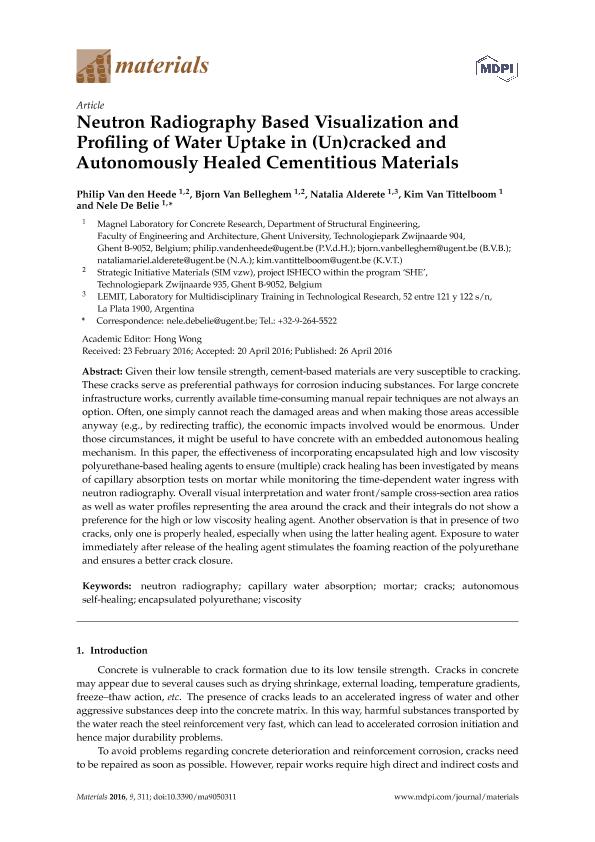Mostrar el registro sencillo del ítem
dc.contributor.author
Van den Heede, Philip
dc.contributor.author
Van Belleghem, Bjorn
dc.contributor.author
Alderete, Natalia Mariel

dc.contributor.author
Van Tittelboom, Kim
dc.contributor.author
de Belie, Nele

dc.date.available
2023-08-23T12:43:26Z
dc.date.issued
2016-04
dc.identifier.citation
Van den Heede, Philip; Van Belleghem, Bjorn; Alderete, Natalia Mariel; Van Tittelboom, Kim; de Belie, Nele; Neutron radiography based visualization and profiling of water uptake in (Un)cracked and autonomously healed cementitious materials; Multidisciplinary Digital Publishing Institute; Materials; 9; 4-2016; 311-339
dc.identifier.issn
1996-1944
dc.identifier.uri
http://hdl.handle.net/11336/209009
dc.description.abstract
Given their low tensile strength, cement-based materials are very susceptible to cracking. These cracks serve as preferential pathways for corrosion inducing substances. For large concrete infrastructure works, currently available time-consuming manual repair techniques are not always an option. Often, one simply cannot reach the damaged areas and when making those areas accessible anyway (e.g., by redirecting traffic), the economic impacts involved would be enormous. Under those circumstances, it might be useful to have concrete with an embedded autonomous healing mechanism. In this paper, the effectiveness of incorporating encapsulated high and low viscosity polyurethane-based healing agents to ensure (multiple) crack healing has been investigated by means of capillary absorption tests on mortar while monitoring the time-dependent water ingress with neutron radiography. Overall visual interpretation and water front/sample cross-section area ratios as well as water profiles representing the area around the crack and their integrals do not show a preference for the high or low viscosity healing agent. Another observation is that in presence of two cracks, only one is properly healed, especially when using the latter healing agent. Exposure to water immediately after release of the healing agent stimulates the foaming reaction of the polyurethane and ensures a better crack closure.
dc.format
application/pdf
dc.language.iso
eng
dc.publisher
Multidisciplinary Digital Publishing Institute
dc.rights
info:eu-repo/semantics/openAccess
dc.rights.uri
https://creativecommons.org/licenses/by/2.5/ar/
dc.subject
AUTONOMOUS SELF-HEALING
dc.subject
CAPILLARY WATER ABSORPTION
dc.subject
CRACKS
dc.subject
ENCAPSULATED POLYURETHANE
dc.subject
MORTAR
dc.subject
NEUTRON RADIOGRAPHY
dc.subject
VISCOSITY
dc.subject.classification
Ingeniería Civil

dc.subject.classification
Ingeniería Civil

dc.subject.classification
INGENIERÍAS Y TECNOLOGÍAS

dc.title
Neutron radiography based visualization and profiling of water uptake in (Un)cracked and autonomously healed cementitious materials
dc.type
info:eu-repo/semantics/article
dc.type
info:ar-repo/semantics/artículo
dc.type
info:eu-repo/semantics/publishedVersion
dc.date.updated
2023-08-15T23:06:34Z
dc.journal.volume
9
dc.journal.pagination
311-339
dc.journal.pais
Suiza

dc.journal.ciudad
Basilea
dc.description.fil
Fil: Van den Heede, Philip. University of Ghent; Bélgica
dc.description.fil
Fil: Van Belleghem, Bjorn. University of Ghent; Bélgica
dc.description.fil
Fil: Alderete, Natalia Mariel. Provincia de Buenos Aires. Gobernación. Comisión de Investigaciones Científicas. Laboratorio de Entrenamiento Multidisciplinario para la Investigación Tecnológica; Argentina. University of Ghent; Bélgica
dc.description.fil
Fil: Van Tittelboom, Kim. University of Ghent; Bélgica
dc.description.fil
Fil: de Belie, Nele. University of Ghent; Bélgica
dc.journal.title
Materials
dc.relation.alternativeid
info:eu-repo/semantics/altIdentifier/doi/http://dx.doi.org/10.3390/ma9050311
dc.relation.alternativeid
info:eu-repo/semantics/altIdentifier/url/https://www.mdpi.com/1996-1944/9/5/311
Archivos asociados
